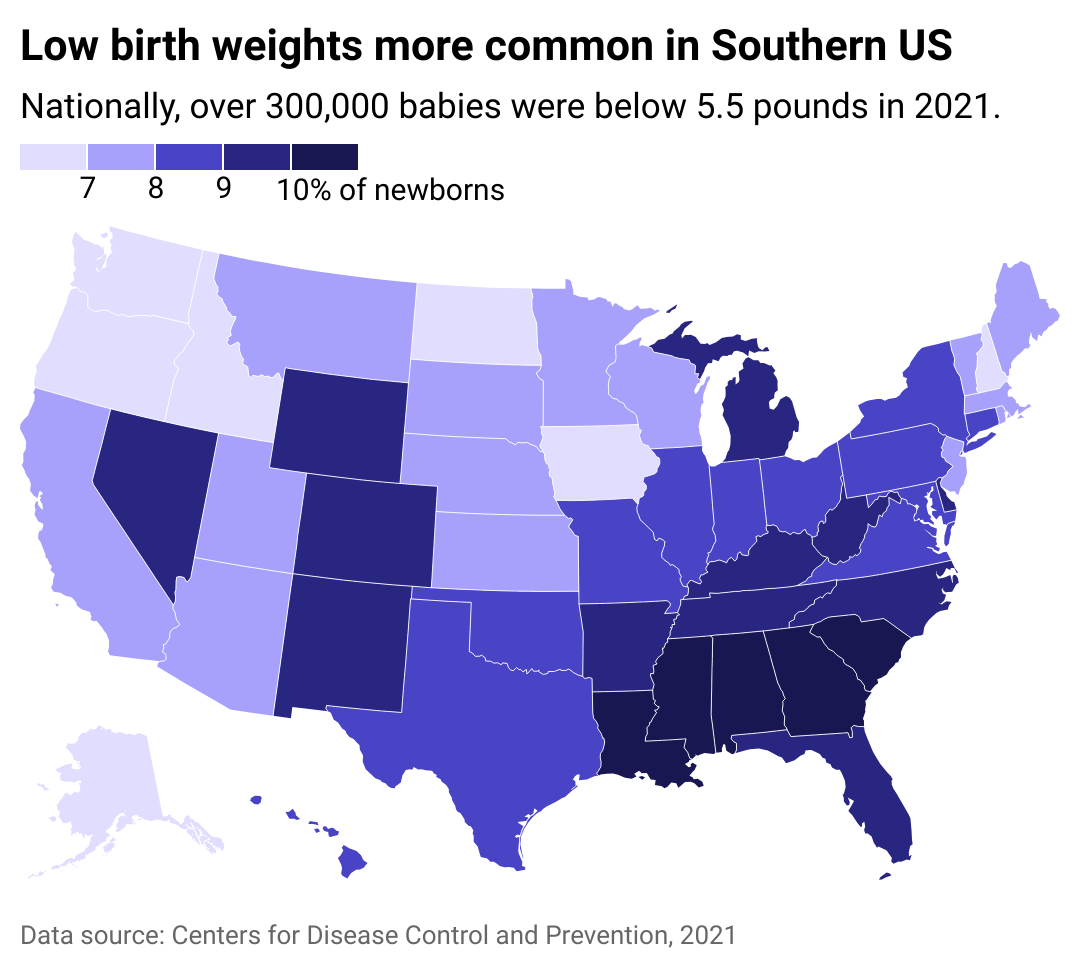
The Southeast has the highest rate of babies with low birth weights
This story originally appeared on Northwell Health and was produced and distributed in partnership with Stacker Studio.
The Southeast has the highest rate of babies with low birth weights
Babies born in the Southeast tend to have the lowest birth weights in the U.S., highlighting a growing regional public health problem, according to 2021 data from the Centers for Disease Control and Prevention.
Northwell Health partnered with Stacker to examine the rates of low-birth-weight babies born in each state, using the latest statistics from the CDC. Federal data shows that more than 10% of babies born in the Southeastern states of Mississippi, Louisiana, Georgia, Alabama, and South Carolina have low birth weights. On average, 8.52% of U.S. newborns have a low birth weight, or weigh under 5.5 pounds at birth.
Because a low-birth-weight newborn is "not as strong as a baby of normal birth weight," low-birth-weight infants may have a harder time gaining weight, breathing, staying warm, eating, and fighting infection, according to Stanford Medicine Children's Health. Potential long-term effects include blindness, cerebral palsy, developmental delay, and deafness. Low birth weight can be caused by infection during pregnancy, premature birth, smoking during the pregnancy, underweight parents, or age of the birth parent (younger than 17 years old or older than 35).
The Southeastern U.S. reports particularly low birth weight for babies. In Louisiana, 11.33% of newborns were low birth weight, the second highest state rate in the nation. Mississippi tops the list, with 12.35% of their babies born with low birth weight annually, with Georgia at 10.6%.
The rate of low birth weights in the Southeast could be partially due to the region's more significant Black population, whose infants are more likely to have low birth weight. Between 2020 and 2022, Black infants were twice as likely to have low birth weight as white infants, at 14.5% vs. 7%, respectively, according to March of Dimes.
Environmental racism and inadequate care may be contributing factors to low birth weight. For example, babies born in the fossil-fuel-plant polluted pocket of Louisiana known as "Cancer Alley,"—a lower-income and predominantly Black region—suffer three times the national average of low birth weights, according to the Environmental Research: Health journal.

Mississippi and Louisiana have the highest levels of low-weight births
Low birth weight is a fatal problem in the U.S. that more than 300,000 babies suffer from annually. According to a research paper from Inquiry: The Journal of Health Care Organization, Provision, and Financing, 35% of infant deaths are due to complications from preterm birth and low birth weight (that are often correlated).
Low birth weight rates are disproportionately high in groups of people who "have experienced inequities, or unfair disparities, like mothers with lower social and economic status and mothers who are Black, due in part to unequal opportunity, differential access to quality health care, and chronic stress related to economic or social adversity such as discrimination and racism," according to a study conducted by researchers at the University of Wisconsin. In Mississippi, for instance, disorders caused by low birth weight are one of the top three leading causes of infant death—of which Black infants are also at high risk—according to the 2021 Mississippi Infant Mortality Report conducted by the state's Office of Health Services.
Experts say that access to better prenatal care and nutrition for pregnant people is needed to improve outcomes. According to the a report from the Center on Budget and Policy Priorities, women who use federal nutrition programs have reduced incidences of low birth weight infants.
While low birth weights are concerning, they may not always signify the worst in health care; the rising low birth weight statistics may be a sign that techniques such as cesareans and induction of labor (which help increase the survival rates of low birth weight babies) are being frequently used, according to a report on infant health from the Organisation for Economic Co-operation and Development. In instances where it results in worse maternal infant health conditions, however, public health programs for improved care and food access can help.
Story editing by Elsie Drexler. Copy editing by Tim Bruns.



